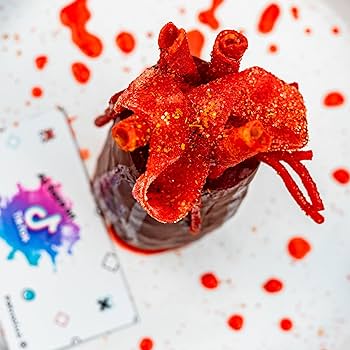Gummy Candy Recipe: History, Ingredients, and Trends
Gummy candy originated in Germany in the early 20th century. Hans Riegel Sr., the founder of Haribo, is credited with inventing the first gummy bear, known as the “Gummibärchen,” in 1922. These cheerful, gelatin-based bears quickly became popular, paving the way for a variety of gummy shapes and flavors. The gummy candy market expanded rapidly, especially in the latter half of the century, as more companies introduced their versions of these chewy treats.
The recipe evolved to include not only gelatin but also other ingredients like corn syrup, sugar, and fruit flavorings. Innovations in gummy candy production led to the creation of worms, rings, and even more intricate shapes. Different regions introduced unique flavors, influenced by local taste preferences, from sour gummies in the US to spicy variants in Asia.
Popular Brands Over the Years
Haribo, established in 1920, remains a dominant brand, especially known for its Goldbears. Trolli, another major player, introduced iconic offerings like gummy worms in the 1980s. The brand’s focus on playful and unusual shapes helped diversify the gummy candy market.
In the US, brands like Black Forest and Albanese gained popularity for their high-quality, natural ingredient gummies. Black Forest gummies, known for being organic, catered to health-conscious consumers. Albanese set itself apart with innovative flavors and textures, offering gummies with distinct, juicy bursts.
Japanese brand Kasugai introduced unique flavors such as lychee and melon, appealing to a broader palate. In recent years, the market saw the rise of boutique brands which focus on gourmet and artisanal gummies, offering options like non-GMO and vegan varieties.
| Brand | Key Products | Notable Features |
|---|---|---|
| Haribo | Goldbears, Happy Cola | Iconic shapes, diverse flavors |
| Trolli | Gummy Worms, Sour Brite Crawlers | Playful shapes, sour options |
| Black Forest | Organic Gummies | Natural ingredients, organic certification |
| Albanese | Assorted Gummies, Sour Gummies | Unique flavors, high-quality textures |
| Kasugai | Lychee Gummies, Melon Gummies | Exotic flavors, high-quality natural flavors |
These brands significantly influenced the gummy candy industry by introducing innovative products and catering to diverse consumer preferences.
Ingredients Used in Gummy Candy
Gelatin and Plant-Based Alternatives
Gummy candy primarily uses gelatin, a protein derived from animal collagen. Gelatin gives gummies their chewy texture and clear appearance. Traditional gummies rely heavily on gelatin for their structure.
For plant-based alternatives, manufacturers often use agar-agar, pectin, or carrageenan from seaweed. Agar-agar creates a firmer texture, while pectin, commonly sourced from fruits, results in a softer chew. These plant-based options cater to vegan and vegetarian preferences without compromising on texture.
Flavors and Coloring
Flavors in gummy candy range widely from fruits to more exotic choices. Popular fruit flavors include strawberry, lemon, and green apple. Some brands experiment with unique flavors such as lychee and melon. Manufacturers use natural flavor extracts or artificial flavors to achieve desired tastes.
Coloring in gummies comes from both natural and synthetic sources. Natural colorings include beet juice, turmeric, and spirulina. Synthetic dyes offer a broader range of vibrant colors but may include additives. The choice between natural and synthetic depends on brand positioning and consumer demand for natural products.
These ingredients together ensure gummy candy remains diverse and engaging for a wide audience.
Process of Making Gummy Candy
Industrial Production
Industrial production of gummy candy involves several key steps. Manufacturers first mix a gelatin solution with water and heat it until fully dissolved. They then add sweeteners, flavors, and colors to the gelatin mixture. Once the mixture reaches a consistent state, it is poured into molds shaped like bears, worms, or other designs. The molds are left to cool and solidify, usually in refrigerated settings. After cooling, the gummies are coated with a fine layer of wax or starch to prevent sticking. Finally, the finished gummies undergo packaging, ready for distribution to stores.
DIY Gummy Candy Recipes
Making gummy candy at home follows a simpler process. Start by heating water in a saucepan, then gradually add unflavored gelatin until it is dissolved. Mix in fruit juice or other flavorings along with a sweetener like honey or sugar. For vegan gummies, use agar-agar or pectin instead of gelatin. Pour the mixture into silicone molds and chill in the refrigerator until set. Homemade gummies can be stored in airtight containers for longer freshness. Experiment with different flavors and colors to create custom gummy candies tailored to your preferences.
Health Considerations
Sugar Content and Dental Health
Gummy candy has high sugar content, which can affect dental health. Sugar feeds bacteria in your mouth, leading to plaque and cavities. The American Dental Association (ADA) notes that frequent consumption of sugary candies increases the risk of tooth decay. To reduce this risk, rinse your mouth with water after consuming gummies and brush your teeth twice daily. Choose sugar-free gummy options to further minimize dental issues.
Vegan and Allergy-Friendly Options
Traditional gummy candy uses gelatin, derived from animal collagen, which isn’t suitable for vegans. However, vegan-friendly alternatives use plant-based ingredients like agar-agar and pectin. These options make gummies accessible to those with specific dietary preferences or restrictions. Additionally, some gummy brands address common allergens. When buying gummy candy, check labels for allergen information and select products certified free from allergens like gluten, dairy, and nuts. This ensures a safer treat for individuals with food allergies.
Recent Trends in Gummy Candy
Gourmet Varieties
Gourmet gummy candy is gaining popularity for its quality and distinct flavors. These varieties often incorporate exotic ingredients, offering taste experiences beyond traditional options. You’ll find flavors like mango chili, elderflower, and lavender, targeting consumers seeking something unique. Premium packaging also adds to their appeal, making them perfect for gifting.
Use of Natural Ingredients
Consumers are increasingly aware of what they consume, driving the demand for natural ingredients in gummy candy. Natural sweeteners like cane sugar and flavors from real fruit juices are becoming standard. Colorings from sources like beetroot and turmeric are being used instead of artificial dyes. This shift aligns with the growing health-consciousness among consumers, making gummy candy a more appealing choice.
Conclusion
Gummy candy has come a long way from its humble beginnings in Germany to becoming a global favorite. Today, there’s a gummy treat for every palate, whether you prefer traditional flavors or gourmet varieties. With the growing trend toward natural ingredients and vegan options, you can enjoy your favorite sweets while aligning with your dietary preferences and health goals. Always check labels for allergens to ensure a safe and delightful experience. Dive into the world of gummy candy and discover the endless possibilities that await.






